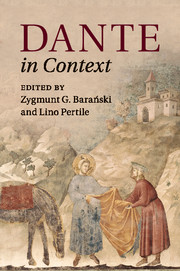Book contents
- Frontmatter
- Dedication
- Contents
- List of illustrations
- List of maps
- Notes on contributors
- Chronology
- Abbreviations and note on translations
- Introduction
- Part I Politics and society
- Part II Intellectual traditions
- Part III Linguistic and literary cultures
- Part IV Visual and performative culture
- Part V Dante: life, works, and reception
- Further reading
- Index
Introduction
Published online by Cambridge University Press: 05 October 2015
- Frontmatter
- Dedication
- Contents
- List of illustrations
- List of maps
- Notes on contributors
- Chronology
- Abbreviations and note on translations
- Introduction
- Part I Politics and society
- Part II Intellectual traditions
- Part III Linguistic and literary cultures
- Part IV Visual and performative culture
- Part V Dante: life, works, and reception
- Further reading
- Index
Summary
The idea for this book came to us as it comes to every university teacher when preparing a list of secondary readings for a course on Dante. One needs to offer a context, namely, an idea of the cultural, historical, intellectual, and geographical conditions in which Dante lived and wrote. What was happening in Florence around the year 1300, and why was Dante banished? Who were the Guelfs and the Ghibellines, and the Whites and the Blacks? And why were the empire and the Church always at loggerheads? How could the Church be so wealthy when St Francis was so poor? There are also trickier questions that one must be ready to answer – questions concerning vernacular and Latin; genre, language, and style; poetry, philosophy, and theology; religion, heresy, and orthodoxy. And questions concerning everyday life: rich and poor; immigration, the expansion of cities, forms of government, and social change; public health, justice, and injustice; literate and illiterate audiences; the condition of women (Dante does not spare them his invectives, yet he is also sensitive to issues of what today we would term gender difference); not to mention family life, lust, and love (why does Dante write so much about Beatrice, and not a word about his wife Gemma?). Answers do exist, but students, and we their teachers, must extract them from scores of scholarly volumes, each dealing with individual aspects of the economy, society, politics, religion, philosophy, art, literature, and music of the time, just to mention the most obvious subjects the knowledge of which would help facilitate an understanding and an enjoyment of Dante's works. In short, there is no single volume, as far as we are aware, either in English or in Italian, that offers a comprehensive overview of the material, cultural, and intellectual world in which Dante became Dante. This book aims to fill this lacuna by providing original essays on a broad array of facets of life in central and northern Italy at the time of Dante Alighieri, roughly between the middle of the thirteenth and the middle of the fourteenth centuries.
Yet despite the range of Dante in Context, its treatment of the late medieval Italian world cannot but be partial and fragmentary. There are issues, such as literature written in Latin in the post-classical age, and especially in the thirteenth and fourteenth centuries, that might have merited chapters of their own.
- Type
- Chapter
- Information
- Dante in Context , pp. 1 - 6Publisher: Cambridge University PressPrint publication year: 2015



